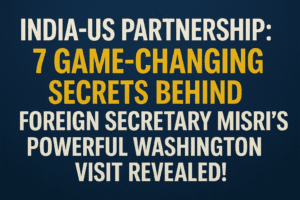India-US Partnership: 7 Game-Changing Secrets Behind Foreign Secretary Misri’s Powerful Washington Visit Revealed!
Foreign Secretary Vikram Misri’s Washington visit underscored both the robust collaboration and persistent friction in the critical India-US partnership. While significant progress was cemented in strategic technology and defense cooperation through the newly prioritized TRUST framework, discussions revealed ongoing US pressure for greater access to India’s markets, particularly in sensitive sectors.
The talks also highlighted a stark divergence on regional dynamics: India firmly rebuffed US claims of mediating the recent India-Pakistan ceasefire, insisting it resulted solely from direct military contacts and rejecting any third-party role. New Delhi reiterated its unwavering position that engagement with Pakistan must remain strictly bilateral and contingent on a terror-free environment. Despite this public disagreement on regional narratives, both nations emphasized the fundamental importance of their partnership for 21st-century stability, advancing cooperation in Quad, IMEC, and I2U2 groupings.
The visit ultimately demonstrated the relationship’s maturity – capable of managing disagreements on complex issues like Pakistan while deepening essential collaboration on technology, defense co-production, and shared Indo-Pacific interests. Success hinges on translating ambitious tech/defense initiatives into tangible outcomes while navigating enduring trade access challenges and respecting India’s strategic autonomy.

India-US Partnership: 7 Game-Changing Secrets Behind Foreign Secretary Misri’s Powerful Washington Visit Revealed!
Foreign Secretary Vikram Misri’s recent three-day visit to Washington wasn’t just another diplomatic exchange; it was a high-stakes calibration of one of the world’s most consequential partnerships. Against a backdrop of regional volatility and global technological competition, the discussions revealed both robust collaboration and persistent friction points demanding nuanced understanding.
The Core Pillars: Trade, Tech, and Security
- Trade: The Persistent Push for Access: While bilateral trade negotiations continue, the US stance was unambiguous. American officials reiterated their long-standing objective: deeper market access within India’s rapidly growing economy. This isn’t merely about tariffs; it reflects US ambitions for its companies to compete more effectively in sectors India considers sensitive, potentially touching on agriculture, digital services, or manufacturing. The challenge lies in balancing this demand with India’s legitimate concerns about protecting domestic industries and strategic economic interests.
- Technology & Defense: Cementing the “TRUST” Framework: The centerpiece was undoubtedly the “India-US Compact for the 21st Century” inter-agency meeting at the White House. Focus centered on implementing the TRUST Initiative (Transforming Relations Utilising Strategic Technologies), effectively replacing the previous iCET. This signifies a formalization and likely expansion of cooperation under the current US administration. Key areas include:
- Critical & Emerging Tech: Joint research, development, and setting standards in AI, semiconductors, quantum computing, and advanced telecommunications (6G).
- Defense Industrial Collaboration: Moving beyond buyer-seller relationships towards co-development and co-production of advanced weaponry and platforms.
- Strategic Energy Partnerships: Collaboration on clean energy and securing critical mineral supply chains.
- Strengthening Multilateral Forums: Reaffirming commitment to the Quad (with Australia and Japan), the India-Middle East-Europe Economic Corridor (IMEC), and the I2U2 (India, Israel, UAE, US) grouping.
- Regional Stability: A Shared Goal, Divergent Narratives: The shadow of the recent India-Pakistan military confrontation and subsequent May 10th ceasefire loomed. The US State Department emphasized “shared desire to maintain regional stability and peace,” highlighting cooperation on migration and counter-narcotics. However, a significant rift surfaced:
- The Ceasefire Disagreement: The US claimed credit for brokering the ceasefire, even suggesting trade incentives were offered. India firmly and repeatedly rejected this narrative. The Ministry of External Affairs (MEA) spokesperson clarified that the cessation of hostilities resulted exclusively from “direct contacts between the DGMOs [Director Generals of Military Operations] of India and Pakistan.” India also categorically dismissed US assertions about planned talks on Kashmir, reiterating its position that dialogue requires a terror-free environment and must remain strictly bilateral.
The Underlying Tensions: What It Means
- Strategic Autonomy vs. Alliance Expectations: India’s forceful pushback on the ceasefire narrative underscores its fierce commitment to resolving issues with Pakistan on its own terms, wary of external mediation or perceived pressure. This highlights the delicate balance India maintains in its US partnership – embracing deep cooperation while guarding its strategic autonomy.
- The “Partnership” Mantra: Despite the friction, both sides consistently reaffirmed the fundamental importance of the relationship. The US called India “a key component of US foreign policy for the 21st century,” while the discussions on TRUST, Quad, IMEC, and I2U2 demonstrate tangible, forward-looking collaboration.
- Trade Remains a Work in Progress: The US push for market access is a constant drumbeat. Finding mutually acceptable solutions here remains one of the most significant challenges to unlocking the full potential of the economic partnership.
The Road Ahead: More Than Just Optics
Misri’s visit wasn’t about grand announcements but about the critical, often gritty, work of managing a complex relationship. It confirmed:
- Deepening Tech & Defense Integration: The TRUST framework provides a structured path for significant advancements in strategic technologies and defense co-production, vital for both nations’ security and economic futures.
- Unresolved Trade Dynamics: Market access issues require sustained, pragmatic negotiation, acknowledging both sides’ red lines.
- India’s Uncompromising Stance on Bilateralism: New Delhi will firmly resist any external narrative or perceived interference in its dealings with Pakistan, especially concerning Kashmir. Its “talks and terror cannot coexist” principle remains non-negotiable.
The true significance of this visit lies in its demonstration of the relationship’s maturity. It can withstand public disagreements on sensitive issues like Pakistan because the foundational strategic convergence – particularly on technology, countering China, and shaping the Indo-Pacific – is strong enough to absorb the friction. The challenge now is translating the ambitious TRUST framework into concrete, mutually beneficial outcomes while navigating the persistent hurdles of trade and divergent regional perspectives. The India-US partnership remains indispensable, but its success hinges on managing these complexities with clear-eyed realism and mutual respect.
You must be logged in to post a comment.